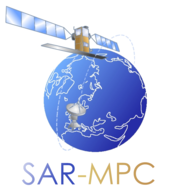
SAR-MPC products
IPF Auxiliary Files
The SAR-MPC oversees the production of the IPF Auxiliary Data Files (ADF) of various types: AUX_INS, AUX_CAL, AUX_PP1, AUX_PP2, AUX_ML2 and AUX_SCS.
Those files are nominally shared to the general public through the Copernicus Data Space Ecosystem. However, as of 22 November 2024 only the Auxiliary Files published after 27 March 2024 are accessible from the Copernicus Data Space Ecosystem. The access to older ADF from Copernicus Data Space Ecosystem will be provided progressively extended.
We provide as well access to the full set of Auxiliary Files from our SAR-MPC website. They can be accessed:
- From the main page were direct access to the latest ADF is provided
- From dedicated pages for each ADF page with filters on mission, instrument configuration id, validity date, etc
- From an adf web api allowing to query and download them
Futhermore, we provide below a set of legacy ADFs published before 26th Novembre 2024 (then not the complete set of ADF) grouped by Sentinel-1 unit and ADF type (except AUX_INS).
Each package contains the corresponding set of ADF together with a complete description of change as separate file.
| Sentinel-1 IPF Auxiliary Data Files | Sentinel-1A | Sentinel-1B |
|---|---|---|
| AUX_CAL (Calibration of L1 processing) | S1A_AUX_CAL_20241128.zip | S1B_AUX_CAL_20241128.zip |
| AUX_ML2 (Machine Learning Models for L2 processing) | S1A_AUX_ML2_20241128.zip | S1B_AUX_ML2_20241128.zip |
|
AUX_PP1 (Processing Parameters for L1 processing) |
S1A_AUX_PP1_20241128.zip | S1B_AUX_PP1_20241128.zip |
|
AUX_PP2 (Processing parameters for L2 processing) |
S1A_AUX_PP2_20241128.zip | S1B_AUX_PP2_20241128.zip |
|
AUX_SCS (Simulated Cross-Spectra for L2 processing) |
S1_AUX_SCS_20241128.zip | |
You can cite the ADFs available on this site as follows
Sentinel-1 IPF Auxiliary Data Files, generated by the SAR-MPC service, available on SAR-MPC website
Burst ID Maps
Sentinel-1 performs systematic acquisition of bursts in both IW and EW modes. The bursts overlap almost perfectly between different passes and are always located at the same place. With the deployment of the SAR processor S1-IPF 3.4, a new element has been added to the products annotations: the Burst ID, which should help the end user to identify a burst area of interest and facilitate searches. Now, we publish complementary auxiliary products, the Burst ID maps.
The maps have a validity that covers the entire time span of the mission and they are global, i.e., they include as well information where no SAR data is acquired. Each entry of the database contains information about burst and sub-swath IDs, relative orbit and burst polygon, and should allow for an easier link between a certain burst ID in a product and its corresponding geographic location.
The maps are public and can be freely downloaded here: [Burst ID Maps 2022-05-30]
The content is provided in sqlite3/spatialite binary (one per mode) and KMZ (one per mode and relative orbit number) formats. Additionally, a README file gives a description of the information provided by the maps, as well as information on the validation procedure and quality statistics.
For questions, please contact Copernicus EO Support (eosupport@copernicus.esa.int) addressing "SAR MPC". The questions will be forwarded to the SAR Mission Performance Cluster Service.
You can cite those burst ID Maps as follows
Sentinel-1 Burst ID Map, version 20220530, generated by the SAR-MPC service, available on SAR-MPC Products